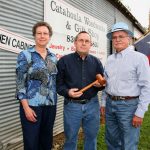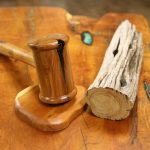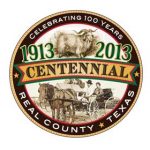As part of our Real County Centennial Countdown, each month County Progress will check in with the Real County Centennial Steering Committee. This month, we learn the history behind the logo, as told by Willis Springfield, committee chairman.
The Real County Centennial Logo
Late for covered wagons, early for Model T Fords, 1913 seemed best remembered with a horse-drawn buggy. An Angora goat was absolutely essential.
Thumbing through my Grandmother Hoover’s ancient photo album I found the picture of a family in a buggy harnessed to a sad but resolute old horse.
Who were these people? Holding my breath I removed the picture from the black page and turned it over. Lizzie Hoover had wisely preserved the identity of this family whose image now appears on the World Wide Web.
“Button,” Lora, and son Hoover, the inscription read. Button was Martin King Jr. who came to Texas from Mississippi with his parents after the Civil War. The family settled near Hoover’s Valley. The town, which grew up around them, was eventually called Kingsland.
Button grew up and married Lora Hoover, the oldest child of Rufusand Lucinda Whitman Hoover who was born in 1871. Hoover King was the fourth and youngest child of this union.
The small snapshot was sent to Suze Sarto, a professional graphic designer, of Round Rock. The logo she produced met with instant approval and is being reproduced on all promotional items and memorabilia pertaining to the Real County Centennial.
Gavel Presented to Real County Centennial Committee


Jimmie and Debbie Walker, owners of Catahoula Woodworks in Leakey, handcrafted a gavel from the heart of an old cedar stay and presented it to Willis Springfield, chairman of the Real County Centennial Steering Committee. The tree the gavel was made from was probably just a tiny sapling a hundred years ago, Walker said.
















